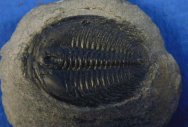Aphelaspis westropi |
|
Name: Aphelaspis
westropi (Formerly Labiostria westropi) According to the Jell & Adrain 2003 Trilobite Genera paper, Labiostria is now a junior synonym of Aphelaspis, fide PALMER, 1965. Therefore Labiostria westropi should be called Aphelaspis westropi. This has been debated post-Palmer, 1965 by both Pratt, 1992 and Chatterton & Ludvigsen, 1998. According to Chatterton & Ludvigsen, 1998, the genus Labiostria is retained for L. westropi, as it more similar to the type species of Labiostria, than it is to the type for Aphelaspis.
“Remarks.—In the Treatise (Moore, 1959), Labiostria was placed by Lochman-Balk in the Pterocephaliidae. However, as shown in this work and by Chatterton et al. (1994b, fig. 6.6), Pterocephalia has a median suture, and a rostellum in at least some stages. At least two specimens of Labiostria (Figure 18.8, 18.9) show what appear to be posteriorly convergent connective sutures, so that there may have been a narrow trapezoidal to triangular rostral plate present. Although a significant fraction of the molts appear to have the cheeks still fused to one another (Figures 18.3, 19.4, 19.6), suggesting that these sutures were not always functional, at least as many specimens were found where the cheeks acted independently during molting (Figure 19.2?, 19.7), implying that this species often had a functional suture. The occasional presence of fine granules or pustules in the anterior border furrow (Figure 18.10), and presence of functional connective sutures, a rostral plate and a doublure that does not extend beyond the border furrow would appear to support assignment of Labiostria to the Idahoiidae. Westrop (1986), however, considered members of that family to have a median suture, showing two free cheeks of Wilbernia explanata (Whitfield) with what could well be a median suture. In other features, our species fits Westrop's (1986) diagnosis for this family. The pustules in the anterior border furrow occur in quite a wide range (at family level) of trilobites (e.g., Proricephalus in Westrop, 1986, pi. 10, figs. 8 and 9; Orygmaspis in Westrop, 1986, pi. 17, fig. 15; Cedaria in Palmer, 1962, pi. 3, fig. 14). It is difficult to judge the phylogenetic significance of this feature at this time. Pratt (1992) included Labiostria in the pterocephalid subfamily Aphelaspidinae. He disagreed with Palmer's (1962) decision to place Labiostria in synonymy with Aphelaspis on the grounds that the former has a median suture (Pratt, 1992, pi. 14, fig. 20; Palmer 1954, pi. 86, fig. 7) and the latter a rostral plate. However, both of the cheeks that Pratt (1992, p. 57) referred to are disarticulated and could have either a median suture or paired connective sutures and a rostral plate, although the connective sutures are not consistent with the almost triangular rostral plate found in L. westropi. Superimposing a tracing of the cheek of Labiostria platifrons Palmer on the cranidium of that species would suggest, if the cheek is complete, that that species had a rostral plate (the tip of the doublure of the free cheek comes nowhere near the midline). This is equally true for the specimens of Labiostria conveximarginata Palmer illustrated by Pratt (1992, pi. 14). Thus, we argue that Labiostria has a rostral plate, but the connective sutures were not always functional. This removes the distinction made by Pratt between Aphelaspis and Labiostria. This leaves the main distinction between Aphelaspis and Labiostria being the depth of the border and pleural furrows and the number of segments in the pygidium. These features may not be sufficient for preventing synonymy of these genera, but since our species is more similar to Labiostria conveximarginata than it is to Aphelaspis walcotti Resser, 1938, the type species of Aphelaspis, we have included our species in Labiostria for the present. We have removed the Aphelaspidinae from the Pterocephaliidae since its members lack a median suture, and often appear to have a triangular to trapezoidal rostral plate.” (quote from Chatterton and Ludvigsen, 1998)
Reference:
Chatterton, B. D. E. and Ludvigsen, R. (1998) Upper Steptoean (Upper Cambrian) trilobites from the McKay Group of southeastern British Columbia, Canada. The Paleontological Society, Memoir 49, Journal of Paleontology, Vol. 72, March, 1998, Supplement to No. 2, 43 pp. |
